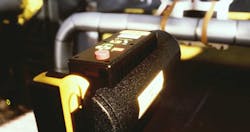Oceaneering develops NDT solution for corrosion detection offshore
Offshore staff
ABERDEEN, UK– Oceaneering has received recognition at the SPE Offshore Achievement Awards’ for its TAXI solution for offshore inspections.
Typically, radiography employs gamma radiation emitting isotopes. According to the company, this upsets nucleonic level control instrumentation on pressure vessels and equipment, causing “trips” that lead to costly unplanned plant shutdowns with associated process safety risks.
Using TAXI Oceaneering’s teams can digitally radiograph pressure piping and infrastructure associated on, or around, equipment fitted with nucleonic detectors. They can do this work while the plant is in-service, using equipment that delivers pulsed X-rays.
The company claims the process provides an optimal non-destructive testing (NDT) solution to detection of corrosion, pipe thinning and potential loss of integrity. It also ensures continuous operations, thereby reducing the risk of loss of primary containment.
TAXI is said to comply with Ionising Radiation Regulations 2017 (IRR17), with no requirement for plant nucleonics isolation. It can reduce deferred inspections, the company adds, and allows in-service inspection of normally inaccessible systems, such as small-bore piping.
Jim McNab, a radiation methods subject matter specialist at the company, said: “Operators often defer radiography inspections into planned shutdowns or rely on less effective inspection methods. This is because, until now, there was no safe, reliable solution to enable equipment and piping systems to be radiographed in the vicinity of nucleonics while the plant is live…
“Our TAXI solution is suitable for detecting and monitoringcorrosion under insulation (CUI), a major issue attributed to around 60% of the North Sea’s piping failures. CUI is difficult to detect and measure, and removing insulation to inspect for signs of corrosion can be costly, time consuming and sometimes unnecessary.”
The system is already operating on various North Sea facilities.
03/21/2019
